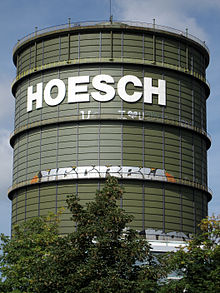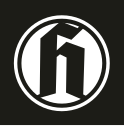Hoesch AG
| Hoesch AG
|
|
|---|---|
| legal form | Corporation |
| founding | 1871 |
| resolution | 1992 |
| Seat | Dortmund |
The Hoesch AG was a major steel and mining company with operations in the Ruhr area and in the Siegerland . It was founded by Leopold Hoesch in Dortmund in 1871 as Eisen- und Stahlwerk Hoesch AG and was taken over in 1992 by the then Krupp Group (now ThyssenKrupp ).
history

The Hoesch family was long before the foundation of the Dortmund company with various metal-processing companies in the Eifel established and operational works in Monschau , Lendersdorf in Düren (since 1819) and Eschweiler (since 1847).
In 1871 Leopold Hoesch founded together with his sons Wilhelm (1845–1923) and Albert Hoesch (1847–1898) as well as his cousins Viktor (1824–1888) and Eberhard Hoesch (1827–1907) a new ironworks in Dortmund in the then province of Westphalia and steelworks in order to take advantage of the locational advantages of the up-and-coming Ruhr area (rich coal deposits, railroad for ore transport).
The new company survived the start-up crisis and in 1899 took over the Westfalia colliery with the associated Kaiserstuhl coking plant . During the Weimar Republic , Hoesch AG was one of the few heavy industry companies that was not integrated into the United Steel Works . In 1930 Hoesch merged with the Cologne-Neu-Essen mining association , and in 1966 with the Dortmund-Hörder Hüttenunion .
After the Nazis came to power in 1933, Hoesch served as an armaments company for the manufacture of tank casings of the Panther and Tiger II types, tank ammunition, gun barrels and armor plates. During the Second World War, the company made extensive use of forced labor. In December 1944, over a third of the workers at the Hoesch iron and steel works were forced laborers.
In 1965 the Hoesch Group achieved sales of 2.358 billion DM and employed 48,600 people. At that time, a fifth of the Dortmund population on wages and salaries was working for " Karl Hoesch ". This term was a lovingly intended declaration of respect among Hoeschians and, as pars pro toto, stands for everything that has to do with the Hoesch company.
On September 2, 1969, the September strike began , a successful wildcat strike .
At the height of the steel crisis , Hoesch merged with the Dutch Koninklijke Hoogovens to form the Estel Group in 1972 on the initiative of Fritz Harders . However, the cooperation was ended again in 1982 at the instigation of the then Hoesch CEO Detlev Rohwedder , who was convinced that the corporate cultures did not match and that the Dutch steel managers were disadvantaging the interests of the Dortmund operations. For the successful reorganization of the Hoesch Group, Rohwedder was named "Manager of the Year" in 1983.
In 1991, Hoesch AG was bought up by what was then the Krupp Group as part of a hostile takeover . The economically profitable Hoesch AG was bought by means of a so-called externally financed takeover by the then highly indebted Krupp AG . This hostile takeover was also the first externally financed takeover of a German stock corporation in German economic history.
Company components
The Hoesch Group included the Dortmund Westfalenhütte , the Hüttenwerke Phönix AG for mining and smelting operations and the Hermannshütte in Hörde , the Hörder Bergwerks- und Hütten-Verein as well as the Hüttenwerk Union in the west of Dortmund city center. The spatial distribution or distance between the blast furnace site in Hörde and the steelworks and rolling mills made expensive transport necessary and was a key cost factor for the company. Hoesch AG also included Hüttenwerke Siegerland AG / Hoesch Siegerlandwerke AG with plants in Kreuztal-Ferndorf , Kreuztal-Eichen and Wissen , and several companies in the field of trade and services, such as the software company mbp , Hoesch Handel and the insurance broker Industriewerte Versicherungskontor as well as a large number of important mechanical engineering companies such as Pohlig Heckel Bleichert ( Weserhütte ), Hoesch Hohenlimburg AG , the former Orenstein & Koppel group , Hoesch Maschinenfabrik Deutschland AG , Hoesch Rothe Erde Schmiedag AG and others.
CEO

- Friedrich Springorum (1898–1919)
- ...
- Fritz Springorum (1924–1930 and 1932–1937)
- Fritz Winkhaus (1930–1932)
- Erich Tgahrt (1937–1945)
- Friedrich Wilhelm Engel (1946–1955?)
- Willy Ochel (1960–1968)
- Friedrich Harders (1968–1973)
- Josef Fischer (1973–1976)
- Heinz Solbach (1976–1979)
- Detlev Rohwedder (1980–1990)
- Karl-Josef Neukirchen (1991–1992)
- Gerhard Neipp (1992)
Todays situation


After the hostile takeover by Krupp and its subsequent merger with Thyssen , most of the former Hoesch group companies now belong to thyssenkrupp AG .
The liquid phase, the production of raw steel iron and steel, was closed in 2001. Today over 1,300 people are still employed on the Westfalenhütte site. Hot strip from the Duisburg smelting works is cold-rolled, annealed and electrolytically galvanized or hot-dip galvanized here.
The products mainly go to the auto industry. The ThyssenKrupp Group's most modern hot-dip galvanizing line is operated in Dortmund. The Dortmund Surface Center, one of the world's leading research and development centers for the surface finishing of flat steel, is also located on the site.
Some parts of the thyssenkrupp group still bear the name of the Hoesch group today:
- Hoesch Rothe Erde
- Hoesch Bausysteme GmbH
- Hoesch Contecna
- Hoesch sheet pile wall and profile (today owned by the Salzgitter Group )
- Hoesch Schwerter Profile GmbH (today owned by Calvi Holding Italy )
After more than 150 years, the name of the company health insurance company Hoesch disappeared on October 1, 2012 through the merger with the local health insurance company .
The former company-owned housing company Hoesch-Wohnungsgesellschaft operated under the name Wohnbau Westfalen and owned a large number of former company apartments in the Ruhr area and Siegerland . In autumn 2007, Wohnbau Westfalen became part of the Evonik group of companies . In 2011, the shareholders' meeting of Evonik Immobilien GmbH decided to change the company's name to Vivawest .
If you approach the city of Dortmund from the south, you will immediately notice the Hoesch Gasometer on the Phoenix-West site with the listed Hoesch logo. The gasometer is one of the few structures that still remain on the Hoesch site.
Since the closure of steel production on Phoenix-Ost, large parts of the production facilities have been dismantled by a Chinese company and brought to China to be rebuilt and produced there. The most modern coking plant in the world, the Kaiserstuhl coking plant , was also dismantled on the Westfalenhütte site and put back into operation in China.
A residential and recreational area with the central Phoenix Lake was built on the Phoenix-Ost site.
The Hoesch Museum in the historic porter's house in the Westfalenhütte is a reminder of the company history of the Hoesch Group in Dortmund . The museum opened on October 23, 2005. In Düren , the art museum Leopold-Hoesch-Museum , donated by the Düren industrialist family Hoesch, commemorates the former founder of Hoesch AG.
See also
literature
- Horst Mönnich: Departure for the area. Departure to Europe. Hoesch 1871–1971 . Munich: Verlag F. Bruckmann, 1971, ISBN 3-7654-1441-7 (anniversary volume of Hoesch Aktiengesellschaft, Dortmund)
- Ottfried Dascher and Christian Kleinschmidt (eds.): The iron and steel industry in the Dortmund area. Economic development, social structures and technological change in the 19th and 20th centuries , (Studies on economic, social and technological history, Vol. 9) Dortmund: Society for Westphalian Economic History eV, 1992, ISBN 3-925227-31-8 ( with 29 contributions).
- Eisen- und Stahlwerk Hoesch Aktiengesellschaft in Dortmund, 1871 - 1921 , Dortmund: Graphische Kunstanstalt W. Crüwell, undated (1921) (memorandum on the occasion of the 50th anniversary of the company, with two time tables, listing the operating facilities of the iron and steel works in Dortmund , Tables on share capital and dividends, steel production and coal production, number of employees and wage development since 1890, as well as numerous illustrations, including a good 20 pen drawings, three site plans of the Westfalenhütte in 1871, 1890 and 1921 and portraits of Leopold, Albert and Wilhelm Hoesch and Friedrich Springorum ), without ISBN.
- Karl Lauschke: The Hoesch workers and their work. Social history of the Dortmund Westfalenhütte during the years of reconstruction 1945 - 1966. (Publications by the Institute for Social Movements, formerly the Institute for Research into the European Workers' Movement at the Ruhr University Bochum, Series A: Representations, Volume 11; at the same time: Studies on economic, Social and Technical History, Volume 17. edited by the Society for Westphalian Economic History eV, Dortmund ), Essen: Klartext Verlag 2000, ISBN 3-88474-746-0 (The work was published by the Political Science Department of the Free University of Berlin in 1998 accepted as a habilitation thesis).
- Karl-Peter Ellerbrock , Gisela Framke and Alfred Heese (eds.): Stahlzeit in Dortmund. Book accompanying the permanent exhibition of the Hoesch Museum, forum on the history of iron and steel and structural change in Dortmund , Münster: Aschendorff Verlag, 2005 ISBN 3-402-00396-1 .
- Karl-Peter Ellerbrock: The story of the "Phoenix" in Hörde , Münster: Aschendorff Verlag, 2006, ISBN 3-402-00406-2 (covers the period from the beginning of industrialization to the last tapping in the Hörder oxygen steelworks on April 28, 2001; the works of art and documentary photos shown come from: Hoesch archive in the ThyssenKrupp corporate archive in Duisburg, Westfälisches Wirtschaftsarchiv foundation in Dortmund, Dortmund city archive and Westphalian state museum for art and cultural history in Münster).
- Hoesch Hohenlimburg GmbH (Ed.): Structure of steel and work. The company history of Hoesch Hohenlimburg 1619–2001 . Years from 1619 to 1969 edited by Werner Hanke, 1970 to 2001 edited. by Georg Goes and Armin Pauwels. Dortmund: Scholz-Druck, 2002, ISBN 3-00-009612-4
Web links
- History of Hoesch AG
- Factory views of Hoesch
- Route of industrial culture : the Hoesch family
- Early documents and newspaper articles about Hoesch AG in the press kit of the 20th century of the ZBW - Leibniz Information Center for Economics .
Individual evidence
- ^ Karl Meurer: Excerpts from: 'The railway history of the city of Eschweiler in data'. In: Series of publications by the Eschweiler history association. No. 12, 1991, ISSN 0724-7745 .
- ↑ New exhibition area: Hoesch in National Socialism: texts, pictures, documents in the Hoesch Museum in Dortmund. In: Nordstadtblogger. Retrieved October 19, 2019 .
- ↑ Stephan A. Jansen (2013): "Mergers & Acquisitions: Company acquisitions and cooperation. A strategic, organizational and capital market theoretical introduction", Gabler: Wiesbaden, p. 45.
- ↑ Stephan A. Jansen (2013): "Mergers & Acquisitions: Company acquisitions and cooperation. A strategic, organizational and capital market theoretical introduction", Gabler: Wiesbaden, p. 46.





